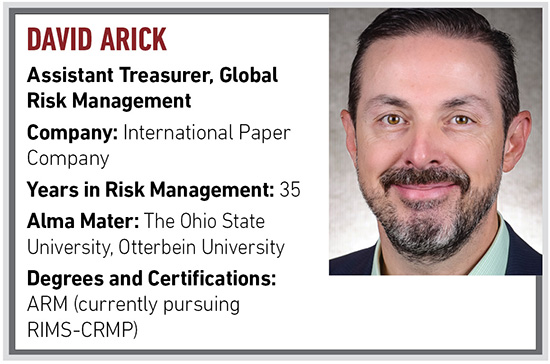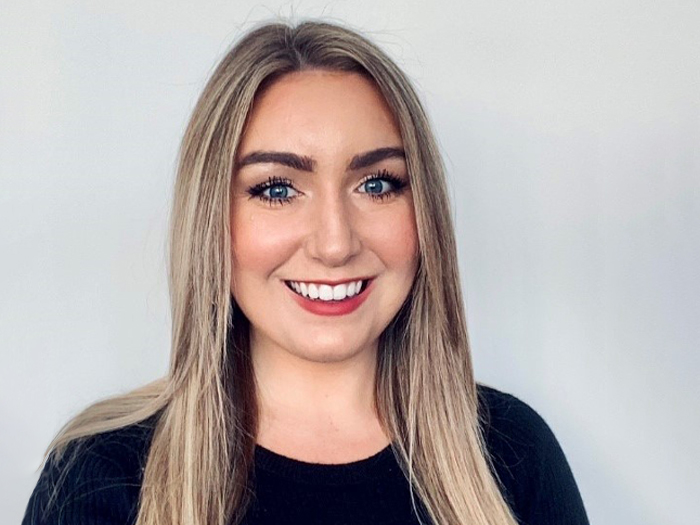2024 RIMS President David Arick Shares How COVID and AI Have Changed the Risk Management Space
R&I: How did you come to your current position?
Prior to International Paper, I was in a role and environment that I was happy with at General Electric, based in Connecticut. I received a call from a recruiter that I knew well, who told me about this risk management opportunity at International Paper that would give me a chance to run my own department (something that I had never done). I also got the sense that this role would allow me to be more impactful, more influential in the company’s risk decision making as opposed to mainly managing property/casualty insurance.
My RIMS involvement started in 1992 or 1993. I was working for a bank in Columbus, Ohio and a few of my colleagues were members of the local RIMS Central Ohio Chapter. They invited me to a RIMS meeting and the rest was history. Eventually, I was asked to volunteer with the local chapter and from there my RIMS involvement progressed. I volunteered in several different roles at the Society level prior to joining the RIMS global Board of Directors in 2019.
R&I: How has the risk management and insurance industry changed since the pandemic?
The ability to collaborate across distance via technology has significantly changed this profession. It is no longer necessary or expected that you fly across the country, to Bermuda, or to London for meetings. Relationships and face-to-face interaction are still really important; however people realize that there are a lot of meetings that can now be just as productive using technology.
The next major shift has been the new work environment and the willingness for organizations to allow their employees to work from home. Remote work requires a lot more deliberate and customized approach to dealing with different people and work styles.
Lastly, we are all more aware of volatility throughout the world. This volatility is felt by people everywhere, but especially where war or conflict is happening, in our supply chains, and where natural disasters occur. We are in a constant state of flux, and risk professionals need to figure out how to adapt to these types of situations beyond insurance.
R&I: You were named RIMS’ president for 2024. What are your key initiatives as you assume your new role?
Risk management is at a crossroads. While the profession’s momentum is at an all-time high, to keep it moving in the right direction it is up to the risk community to step out of their comfort zones, sharpen their skills, and set their collective goals even higher. To truly tap risk management’s limitless potential, individually, we must be bold and dive into uncharted professional waters. Together, this professional community must dive into professional development, volunteerism, and advocacy to strengthen the future of risk management while also creating opportunities for advancing students, early-career professionals, and seasoned risk leaders alike. I strongly believe that RIMS can help us get this done.
R&I: What most excites you about this role? What do you think will be the most challenging?
I am excited to be able to give back and, perhaps, have a moment of influence on the profession. I am excited for the opportunity to meet with people who are very influential in this space, to learn from them, and work with them to advance the risk management profession.
It appears everything is challenging these days. That said, successfully serving this Society will require balance. It will require balancing personal ambitions, organizational ambitions, and RIMS’ ambitions. It is on me to give 100% to my day job, 100% to RIMS and 100% to my family. It might sound like a tall order, but I am confident that my passion and commitment to all three will make that challenge 100% achievable. It could temporarily hurt my golf game, though…
R&I: What is the risk management community doing right?
In the face of so much adversity, when almost every risk seemed to manifest at the same time, risk professionals stood tall. The risk community successfully positioned themselves as integral strategic leaders whose skills and knowledge unlocked doors for executives to make better, more informed and more agile decisions.
R&I: What could the risk management community be doing a better job of?
Creating a pipeline for the future of risk management profession is important. As a community and individually we need to help support and develop greater offerings at the university level for aspiring students. But that commitment can’t stop there. Once individuals choose risk management as their career, how can we then lend our expertise and experiences to support these future risk leaders? We have really smart and talented people choosing risk management as a career, and it’s up to us to keep them here.
R&I: How would you say technology, particularly the use of artificial intelligence, has impacted the risk management profession?
AI is going to increase in its impact in the risk management profession, but we are still in the early days of understanding how it will be applied in different industries. So, while it is early, I think we can say with certainty that it will be a game-changer and it will be profound. Risk professionals will have to keep their eyes on its development, think about the outcomes of its implementation, and carefully follow how it is being applied within our own organizations, as well as vendors, customers, and other groups we interact with.
While we keep our eyes on AI, machine learning and data analytics has improved our ability to model for the future. That’s where talent comes in: smart people are needed to dissect that information, to help the organization understand what is meaningful for making decisions and driving behavior, and what is just noise.











